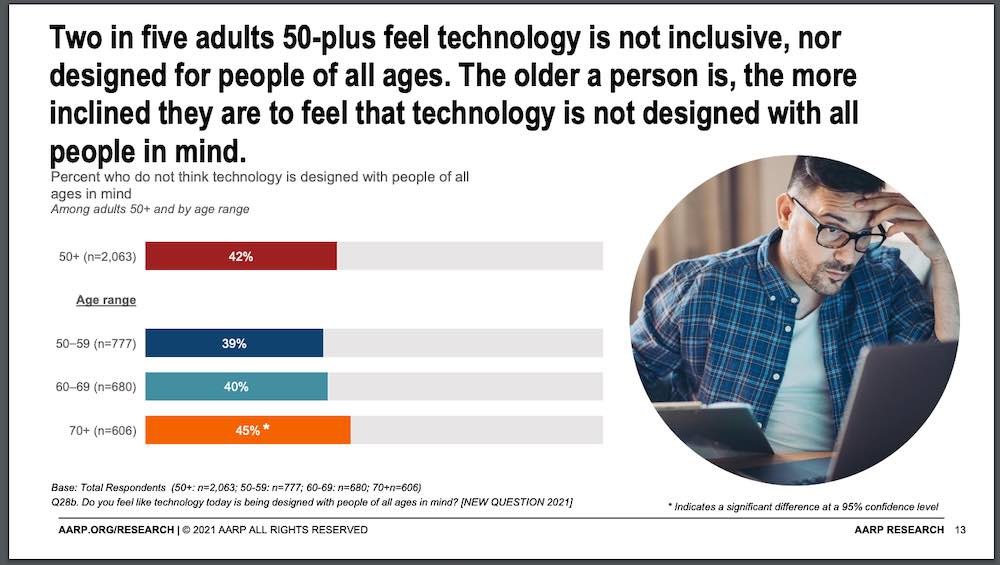
Will Boomers Force Digital Accessibility Adoption?
- Dave Gibson | President
The Boomer Factor
Even after thousands of lawsuits and other legal actions made by plaintiffs, the DOJ, and other agencies at state and federal levels, substantive adoption of digital accessibility has yet to take hold.
I base this assertion on the results of the WebAIM One Million report. Here, Utah State University’s Institute for Disability Research, Policy, and Practice tests of the top one million home pages for web accessibility and WCAG compliance. Their 2021 report showed that 96.8% of homepages had significant accessibilty barriers. And not just one or two. The average was 51.4 errors per page.
When only around 3% of websites are essentially accessible, I'd call that failure.
The "stick" of fear of an ADA lawsuit is just not enough. We need to add the carrot. And in this case, I think the Baby Boomer can deliver that carrot.
As Boomers age, many experience the same challenges as people with disabilities accessing websites, apps and technology in general. They share the same frustration with poor usability, confusing navigation, cluttered desgin. Endless upgrades and updates. "Seemless integrations". They struggle with technologies and user experiences that are just not designed for people with diminishing sight, hearing, motor skills and cognition.
Boomers are now experiencing the same barriers as people with disabilites.
Now. What if these two groups were to allign and focus their collective power to address digital accessibility?
Boomer Power
Recently Boomers fell behind Millennials’s at 70M, but carry the most economic weight. As of the end of 2021, Boomers controlled half (50.3%) of all US household wealth. Annually, they spend $548B - which is 54% over the next big spenders - Generation X. (Epsilon Research)
Not only is this a wealthy generation, it is also tech-savvy. Despite the ageist tropes, Boomers have been using computers and technology throughout their adult life. And as the process of natural aging affects vision, hearing, motor skills, and cognition, the demand for accessible technologies and products from this generation will increasingly align with those of people with disabilities.
Investment in and use of technology by seniors grew even more during the pandemic. Families began connecting over Zoom and grandparents joined in. Sales of all mobile devices grew. According to AARP's 2022 Tech Trends over 50 Report, over 75% of those over 50 use technology to stay connected. The largest growth on Facebook still are those over the age of 50. This is a digital generation… the first digital generation.
Yet AARP’s 2021 Tech Trends Report cited 42% feeling technology is not inclusive or designed for all ages, citing poor design and usability.

source AARP 2022 Tech Trends and The 50-Plus
These complaints correspond with those of people with disabilities.
People with Disabilities Carry Significant Weight Also
People with disabilities are also a powerful consumer group. While not quite as large or wealthy as Boomers, the after tax disposable income of the 61M people with disabilities is a whopping $490B, which rivals Blacks ($501B) and Hispanics ($582B).
Now consider how powerful these combined interests would be if connected. Both groups deal with similar ableism and ageism discrimination, and are frustration with the lack of usability of increasingly complex user experiences and devices.
As my grandmother never said, where there is need and disposable income, there is business opportunity.
The Pandemic Factor
During the pandemic and since, three forces have collided to heighten the need for digital accessibility.
First, there already existed a cottage industry of plaintiff attorneys going after brands large and small for ADA violations of websites, mobile apps, and content. The pandemic caused barely a hiccup in the flow of demand letters and lawsuits. Where other areas of business had to shutter, these trolling firms continued to grow and maintain the number one catalyst for forced accessibility.
Second, the pandemic forced everyone inside and onto their digital devices to learn, communicate, shop, and keep from going stir crazy. The elderly and people with disabilities were disproportionately left in the dark. Awareness around digital accessibility grew as the world suddenly shifted even more online.
Third, George Floyd’s murder sparked the movement that called for Diversity, Equity, and Inclusion. Brands had to quickly cleanse and establish DEI policies. Such policies also provide leverage for both internal and external interests to push for digital inclusion of corporate websites, apps, and internal systems.
This momentum that already existed toward accessibility has the potential to explode once brands realize the value of these untapped markets. Once they do, brands that focus on the accessibility of products and digital properties will reap the rewards of multiple bottom line growth.
Adopting Universal Design & Embracing Digital Accessibility Is THE Business Opportunity
Universal Design ensures that all users can access the same spaces regardless of ability. If we learned one thing from the pandemic, it's that access to digital spaces is a huge part of life today. And it’s immoral to continue ignoring the need for universal accessibility.
Brands that see this opportunity will gain access to larger markets and multiple bottom lines. Those that continue discriminating against the elderly and those with disabilities… good luck with that.